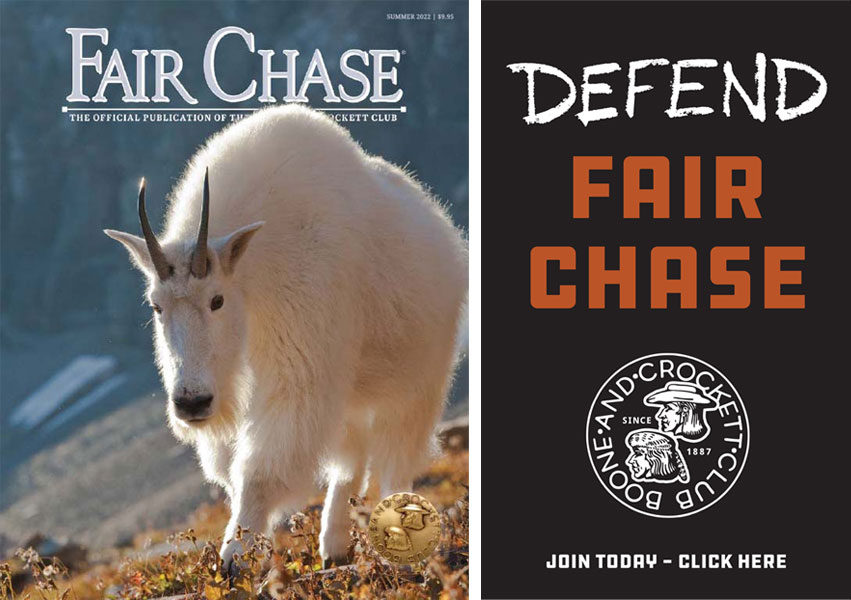Iowa's Wildlife Science Legacy
SCIENCE BLASTS
By John F. Organ, B&C Professional MemberExcerpt from Winter 2015 issue of Fair Chase
The state of Iowa has had a pivotal role in the origins and evolution of wildlife conservation in North America. Not surprisingly, key Iowans who have had major influence in this heritage were Boone and Crockett Club members. Aldo Leopold, the father of wildlife management was born in Iowa. Congressman John Lacey from Iowa sponsored the Yellowstone Park Protection Act of 1894 and the Game and Wild Birds Preservation and Disposition Act of 1900, also known as the Lacey Act. The Yellowstone Act was the first act to halt the market hunting of big game in Yellowstone, and the Lacey Act would later become the most important federal anti–poaching law in the United States. J.N. “Ding” Darling led Iowa’s Conservation Commission and became the director of the now U.S. Fish and Wildlife Service, where he established the Federal Duck Stamp and the Cooperative Wildlife Research Units.
As president of Iowa State University and a Boone and Crockett Club member, I recognize and appreciate the critical importance of fish and wildlife research. Iowa State’s Department of Natural Resource Ecology and Management has a history of innovation and excellence and has been partnering with the first-ever Cooperative Fish and Wildlife Research Unit for more than 80 years. The dedicated work of our faculty and students is having a substantive impact on efforts to improve fish and wildlife management through basic and applied research and extension to managers and decision- makers. I’ve elevated the priority of this issue at ISU by providing presidential discretionary funds to launch nine new research projects in this area, and I would urge that wildlife management and conservation research also be elevated as a national priority.
— Steven Leath President, Iowa State University
Iowa State University (ISU) was the first college in the nation to apply for status as Land Grant academic institution, under the Morrill Act in 1862. ISU has been front and center during the evolution of wildlife conservation. Home to the first Cooperative Wildlife Research Unit, it is also the first university to establish a Cooperative Agricultural Extension program. It is to my knowledge the only university whose current president, Dr. Steven Leath, is a regular member of the Boone and Crockett Club. Not surprisingly, ISU is conducting science today that has important applications to wildlife management. I will highlight a small portion of the ongoing research that is of particular interest to Club members.
The Iowa Cooperative Fish and Wildlife Research Unit with faculty at ISU and Iowa Department of Natural Resources (DNR) have a long and diverse history of studying whitetail deer. Students have studied whitetail deer in relation to state parks and a proposed impoundment of the Des Moines River. Craig Huegel completed a pioneering study of fawn behavior, movement, and survival in 1985 that is still commonly cited. Other students have investigated techniques to monitor deer populations through tracking stations and spotlight surveys.
Iowa State University in collaboration with the Iowa DNR has begun two new research projects on whitetail deer. The goal of the first project is to identify factors associated with the abundance and spatial distribution of high antler scoring whitetail deer in Iowa. The initial focus of this project will be an analysis of spatial and temporal trends in the harvest of trophy male deer in Iowa reported in Iowa’s trophy record book. The next step will be to identify relationships between antler characteristics of contemporarily harvested deer and habitat features at a finer-scale. Identifying factors associated with the abundance and spatial distribution of deer in Iowa with high antler scores could help managers and landowners to promote these characteristics. The goal of the second project is to estimate fawn survival rates in central Iowa using radio collared fawns. These estimates will be used to validate the deer population models currently used by the DNR and to see if there are habitats that managers and landowners can create to help improve fawn survival.
Students are also using genetics to look at dispersal and population structure of deer at local and regional scales. Additionally, they are evaluating how wildlife agencies can best communicate the risk of chronic wasting disease to multiple stakeholders.
Conducting research to reduce uncertainty and improve management—what we term “actionable science”—has distinguished wildlife conservation in North America from conservation in many other parts of the world. The close working relationship between universities and management agencies is something we take for granted, but it is novel in other nations. In recent years, wildlife managers have sensed a drift from this core base of academia towards less applied research, and a growing gap between science and management. Iowa State University, the Iowa DNR, and the Iowa Cooperative Fish and Wildlife Research Unit have remained true to the ideals of our conservation pioneers, and promise to continue to advance wildlife conservation in this great state in the heartland of America.
More Science Blasts
Read more articles about conservation, hunting, and wildlife research by John Organ, Director Emeritus of the USGS Cooperative Fish and Wildlife Research Units, and current B&C professional member.
Interested in More?
Image

|
